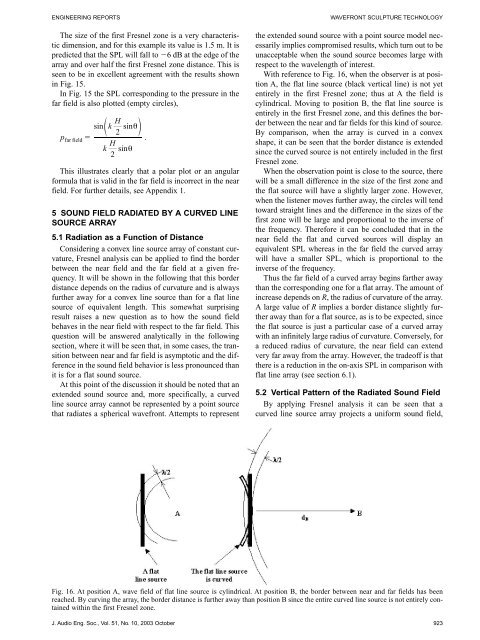Wavefront Sculpture Technology - R+R Sonicdesign AG
Wavefront Sculpture Technology - R+R Sonicdesign AG
Wavefront Sculpture Technology - R+R Sonicdesign AG
Create successful ePaper yourself
Turn your PDF publications into a flip-book with our unique Google optimized e-Paper software.
ENGINEERING REPORTS WAVEFRONT SCULPTURE TECHNOLOGY<br />
The size of the first Fresnel zone is a very characteristic<br />
dimension, and for this example its value is 1.5 m. It is<br />
predicted that the SPL will fall to �6 dB at the edge of the<br />
array and over half the first Fresnel zone distance. This is<br />
seen to be in excellent agreement with the results shown<br />
in Fig. 15.<br />
In Fig. 15 the SPL corresponding to the pressure in the<br />
far field is also plotted (empty circles),<br />
p<br />
far field<br />
sin sinθ<br />
.<br />
k sinθ<br />
H<br />
k H<br />
e o<br />
2<br />
�<br />
2<br />
This illustrates clearly that a polar plot or an angular<br />
formula that is valid in the far field is incorrect in the near<br />
field. For further details, see Appendix 1.<br />
5 SOUND FIELD RADIATED BY A CURVED LINE<br />
SOURCE ARRAY<br />
5.1 Radiation as a Function of Distance<br />
Considering a convex line source array of constant curvature,<br />
Fresnel analysis can be applied to find the border<br />
between the near field and the far field at a given frequency.<br />
It will be shown in the following that this border<br />
distance depends on the radius of curvature and is always<br />
further away for a convex line source than for a flat line<br />
source of equivalent length. This somewhat surprising<br />
result raises a new question as to how the sound field<br />
behaves in the near field with respect to the far field. This<br />
question will be answered analytically in the following<br />
section, where it will be seen that, in some cases, the transition<br />
between near and far field is asymptotic and the difference<br />
in the sound field behavior is less pronounced than<br />
it is for a flat sound source.<br />
At this point of the discussion it should be noted that an<br />
extended sound source and, more specifically, a curved<br />
line source array cannot be represented by a point source<br />
that radiates a spherical wavefront. Attempts to represent<br />
the extended sound source with a point source model necessarily<br />
implies compromised results, which turn out to be<br />
unacceptable when the sound source becomes large with<br />
respect to the wavelength of interest.<br />
With reference to Fig. 16, when the observer is at position<br />
A, the flat line source (black vertical line) is not yet<br />
entirely in the first Fresnel zone; thus at A the field is<br />
cylindrical. Moving to position B, the flat line source is<br />
entirely in the first Fresnel zone, and this defines the border<br />
between the near and far fields for this kind of source.<br />
By comparison, when the array is curved in a convex<br />
shape, it can be seen that the border distance is extended<br />
since the curved source is not entirely included in the first<br />
Fresnel zone.<br />
When the observation point is close to the source, there<br />
will be a small difference in the size of the first zone and<br />
the flat source will have a slightly larger zone. However,<br />
when the listener moves further away, the circles will tend<br />
toward straight lines and the difference in the sizes of the<br />
first zone will be large and proportional to the inverse of<br />
the frequency. Therefore it can be concluded that in the<br />
near field the flat and curved sources will display an<br />
equivalent SPL whereas in the far field the curved array<br />
will have a smaller SPL, which is proportional to the<br />
inverse of the frequency.<br />
Thus the far field of a curved array begins farther away<br />
than the corresponding one for a flat array. The amount of<br />
increase depends on R, the radius of curvature of the array.<br />
A large value of R implies a border distance slightly further<br />
away than for a flat source, as is to be expected, since<br />
the flat source is just a particular case of a curved array<br />
with an infinitely large radius of curvature. Conversely, for<br />
a reduced radius of curvature, the near field can extend<br />
very far away from the array. However, the tradeoff is that<br />
there is a reduction in the on-axis SPL in comparison with<br />
flat line array (see section 6.1).<br />
5.2 Vertical Pattern of the Radiated Sound Field<br />
By applying Fresnel analysis it can be seen that a<br />
curved line source array projects a uniform sound field,<br />
Fig. 16. At position A, wave field of flat line source is cylindrical. At position B, the border between near and far fields has been<br />
reached. By curving the array, the border distance is further away than position B since the entire curved line source is not entirely contained<br />
within the first Fresnel zone.<br />
J. Audio Eng. Soc., Vol. 51, No. 10, 2003 October 923




